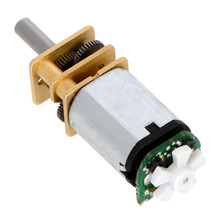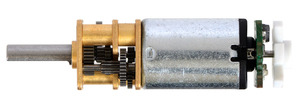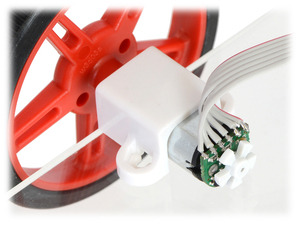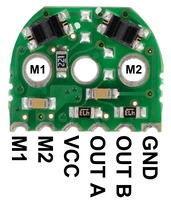Pololu Blog »
New products: Optical encoders for micro metal gearmotors
Posted by Ben on 13 September 2013
6 comments
Tags: new products
Those encoders we mentioned last week are finally here! Here are some pictures:
|
|
|
|
Check out the product page for more details.
6 comments
One thing, me and more people, are waiting for long is an extended shaft version of 1:5 HP micromotor. Why you do not have it already?
Hello.
We are definitely planning on expanding our selection of motors with backshafts now that we have encoders for them. Generally speaking, the 5:1 gear ratios have not been very popular, so I'd be interested to hear more about what you want to do with them.
-Jon
We are definitely planning on expanding our selection of motors with backshafts now that we have encoders for them. Generally speaking, the 5:1 gear ratios have not been very popular, so I'd be interested to hear more about what you want to do with them.
-Jon
Would this encoder work on a 3Pi or a Zumo? Encoders are one thing that both of these platforms are lacking. Anyway, this looks like a great solution for other small robots.
Thanks,
-Ted
Thanks,
-Ted
Hi, Ted.
There are two aspects to this: physically getting the encoders in there and doing something with the signals.
I'll deal with the computational part first since that applies to any platform. At the top end of the performance, the motors and encoders give you about 10,000 counts per second, and with two motors, that's 20 events per millisecond. So, you would likely need something much more powerful than an ATmega328 type of processor to deal with that and still do something interesting, like maybe some trigonometry.
On the 3pi, the encoders could fit in the original motor postions but they would partially block the expansion port, and getting the motor leads connected to the existing motor connection points would be tricky. You can get around that by going to the extended brackets, which would let the encoders fit without blocking anything but would also make your wheels stick out more.
The encoders fit in the Zumo chassis, though you will have to figure out how to get the wires from there to your own electronics (our existing Arduino shield does not support the encoders, so it's not a useful starting point even if you had something more powerful than a regular Arduino to plug into it).
- Jan
There are two aspects to this: physically getting the encoders in there and doing something with the signals.
I'll deal with the computational part first since that applies to any platform. At the top end of the performance, the motors and encoders give you about 10,000 counts per second, and with two motors, that's 20 events per millisecond. So, you would likely need something much more powerful than an ATmega328 type of processor to deal with that and still do something interesting, like maybe some trigonometry.
On the 3pi, the encoders could fit in the original motor postions but they would partially block the expansion port, and getting the motor leads connected to the existing motor connection points would be tricky. You can get around that by going to the extended brackets, which would let the encoders fit without blocking anything but would also make your wheels stick out more.
The encoders fit in the Zumo chassis, though you will have to figure out how to get the wires from there to your own electronics (our existing Arduino shield does not support the encoders, so it's not a useful starting point even if you had something more powerful than a regular Arduino to plug into it).
- Jan
Hello, My optical sensor on the encoders was broken uncareful, I want to fix it myself. Can u tell my how to find the sensors?
Hi, Yang.
You can find the datasheet for the sensor used in our optical encoder kits under the "Resources" tab of either of their product pages. For example:
http://www.pololu.com/catalog/product/2590/resources
How did your sensor break?
-Jon
You can find the datasheet for the sensor used in our optical encoder kits under the "Resources" tab of either of their product pages. For example:
http://www.pololu.com/catalog/product/2590/resources
How did your sensor break?
-Jon
















